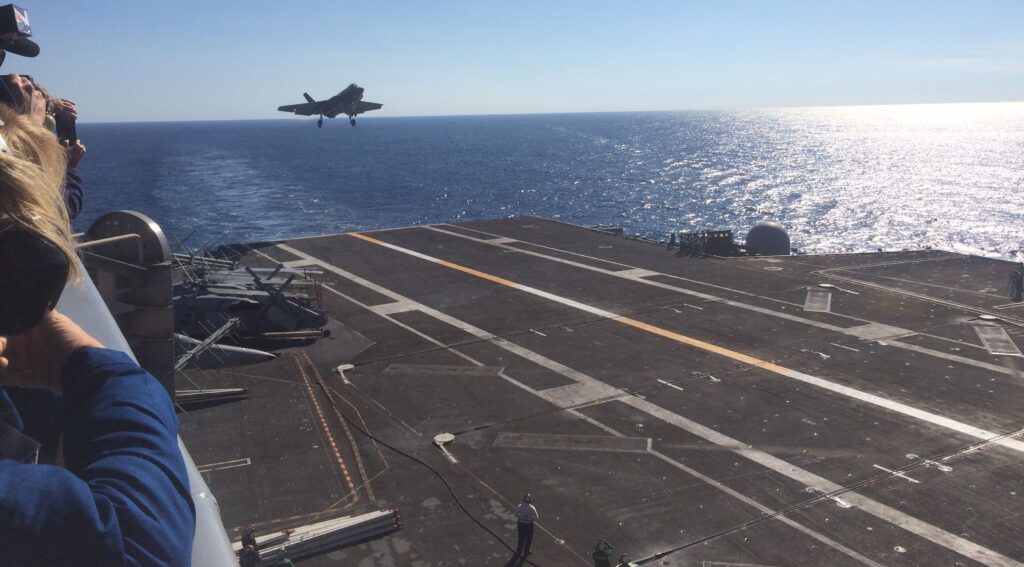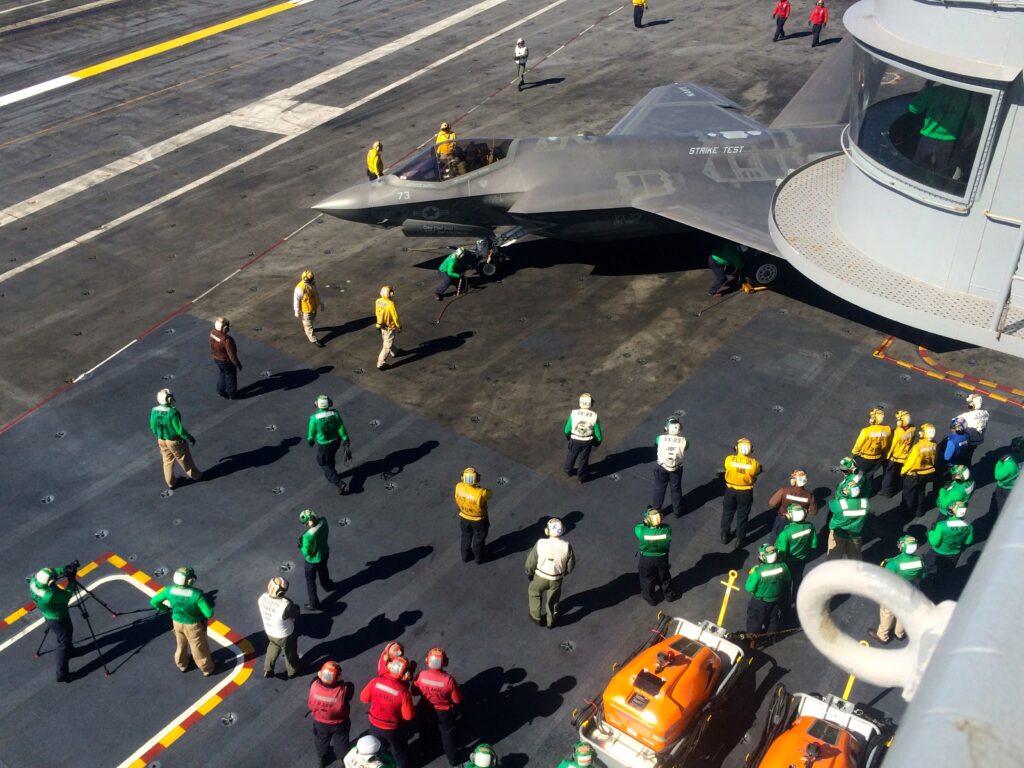 ABOARD USS NIMITZ: The first F-35C seemed to float through the air toward the slowly pitching deck of the USS Nimitz, looking as if it was hanging by a wire and heading implacably to the ship’s arresting wires. The weather was gorgeous, with the massive carrier sailing some 40 miles off the San Diego coast through small swells and under gorgeous cloud-scudded cerulean blue skies.
ABOARD USS NIMITZ: The first F-35C seemed to float through the air toward the slowly pitching deck of the USS Nimitz, looking as if it was hanging by a wire and heading implacably to the ship’s arresting wires. The weather was gorgeous, with the massive carrier sailing some 40 miles off the San Diego coast through small swells and under gorgeous cloud-scudded cerulean blue skies.
The F-35C’s wings didn’t wobble at all on final approach as test pilot Cdr. Tony “Brick” Wilson guided her in. And on its first try the plane’s tail hook grabbed the third arresting wire — the catch most favored by Navy pilots — at 12:19 pm. When an F-18 Hornet landed minutes later, the plane’s wings twitched slightly up and down on its approach and the pilot snagged the fourth wire, second to the bottom in the Navy hierarchy of carrier landing awards.
Then the second F-35C test plane came in just as steady and firm as the first. It also snagged the third wire, sending a clear message to the Navy’s aviation community that the Lockheed Martin plane not only could handle carrier landings, but could execute them with aplomb.
The word historic got thrown around the deck of the Nimitz quite a bit today.
“You are going to look back on this day as a very historic occasion,” the Navy’s Air Boss, Vice Adm. David Buss, told ship’s company a few hours before the landings.
Perhaps the best quote of the day came from a visibly pumped Brick Wilson:
“Today is a landmark event in the development of the F-35C. It is the culmination of many years of hard work by a talented team of thousands. I’m very excited to see America’s newest aircraft on the flight deck of her oldest aircraft carrier, the USS Nimitz.”
But the F-35C’s landings today also underscored that, while the Navy certainly doesn’t oppose the F-35C, its leadership also hasn’t shown great enthusiasm for the stealthy aircraft, especially when compared to the leadership of the Marines and the Air Force. (Note that the F-35C is not designed to replace but to fly with the F/A-18 E/F Super Hornet.) Today may well help change the opinions of some senior Navy commanders, especially if the rest of the testing proceeds as well. The Air Boss, who might be more receptive to the Joint Strike Fighter than some of his bosses, told reporters that today’s landings will be a “springboard to our future.”
There was one glitch to today’s testing. The F-35C’s first catapult launches were postponed because of glitches with some of the test sensors, which were not relaying data to testers. The Nimitz tests are scheduled to continue for two weeks. It will include night landings around the last three days of testing, Buss told me on the flight deck. Until the night landings, the Nimitz crew and the F-35C pilots will “gradually expand the flight envelope,” putting the plane through its paces by forcing it to land into the wind, against the wind and to take off using all of the ship’s four catapults, he said. A Navy officer familiar with the program told reporters it will probably take four months to go through the enormous data that flows from these tests.
This batch of testing is called DT-1. It will be followed by DT-2 at the end of next summer and DT-3 in the spring of 2016. You’ll get more F-35C testing coverage after Tuesday’s elections.
Northrop sees F-16 IVEWS, IBCS as ‘multibillion dollar’ international sales drivers
In addition, CEO Kathy Warden says the company sees a chance to sell up to five Triton UAVs to the NATO alliance.



























